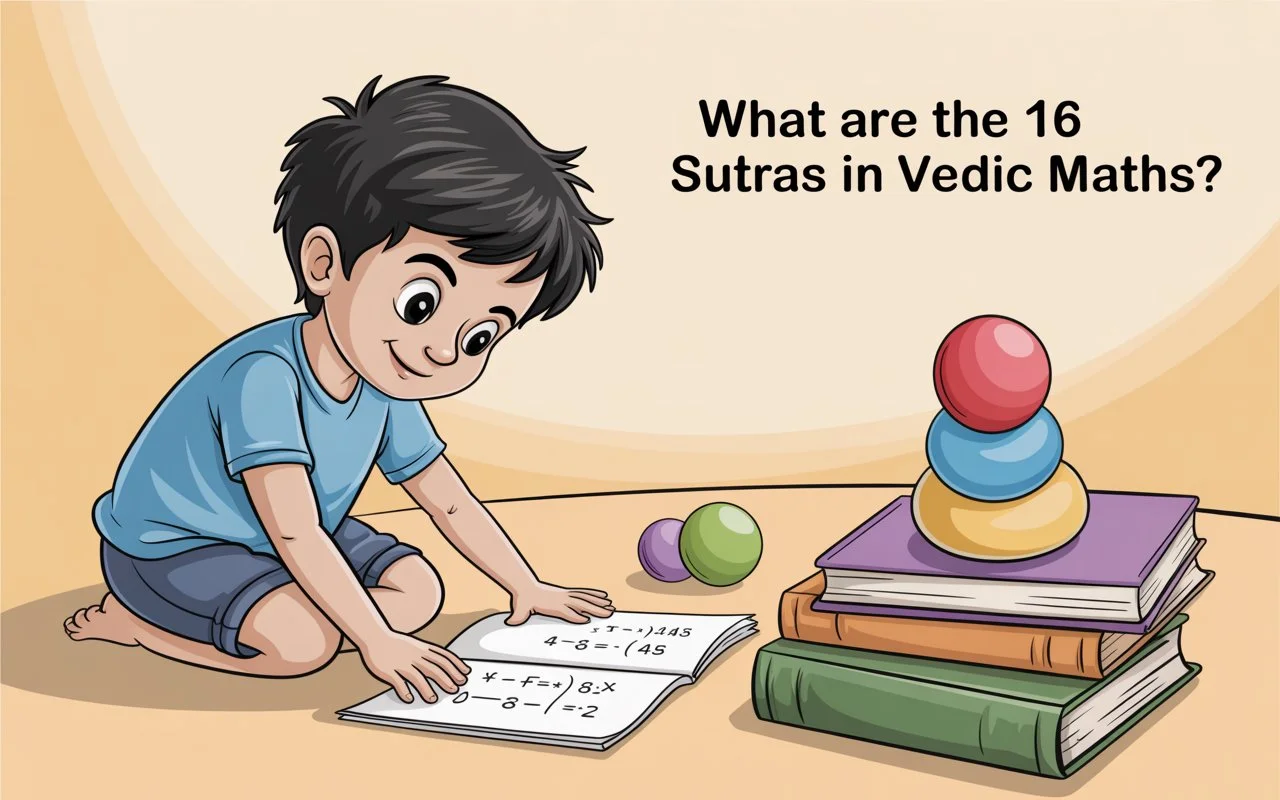Vedic Sutras: What are the 16 Sutras in Vedic Maths? Explained with Examples




Vedic Maths is an ancient Indian system of mathematics derived from the Vedas. The "father of Vedic math" is generally considered to be Jagadguru Shri Bharati Krishna Tirthaji Maharaja, also known as Shri Bharati Krishna Tirtha.
It includes mental techniques based on 16 powerful formulas, or "sutras," that simplify and speed up calculations. Knowing these sutras is helpful for students preparing for competitive exams.

Vedic Maths is a system of calculation techniques based on ancient Indian scriptures. These sutras make arithmetic and algebraic operations much faster and easier. Unlike traditional methods, which rely on lengthy steps, Vedic methods help you arrive at answers mentally with minimal effort.
Key Benefits:
To know more about Vedic Maths, check out the bog given below,
There are 16 main Sutras (formulas) and 13 Sub-Sutras (sub-formulas) in Vedic Maths. These cover operations such as addition, subtraction, multiplication, division, squares, and square roots.
No. | Sutra Name | Meaning | Common Use |
| 1 | Ekadhikena Purvena | One more than the previous | Squaring numbers ending in 5 |
| 2 | Nikhilam Navatashcaramam Dashatah | All from 9 and the last from 10 | Multiplying numbers near base (10,100) |
| 3 | Urdhva-Tiryagbyham | Vertically and crosswise | General multiplication |
| 4 | Paravartya Yojayet | Transpose and adjust | Solving simple equations |
| 5 | Shunyam Saamyasamuccaye | When the sum is the same, it is zero | Solving algebraic equations |
| 6 | Anurupye Shunyamanyat | If one is zero, the other is equal | Solving proportion-based problems |
| 7 | Sankalana-Vyavakalanabhyam | By addition and subtraction | Solving equations |
| 8 | Puranapuranabhyam | By the completion or non-completion | Addition and subtraction |
| 9 | Chalana-Kalanabhyam | Differences and similarities | Calculus and algebra |
| 10 | Yavadunam | Whatever the extent of its deficiency | Squaring numbers below base |
| 11 | Vyashtisamanstih | Part and whole | Arithmetic operations |
| 12 | Shesanyankena Charamena | Remainder by the last digit | Finding remainders |
| 13 | Sopaantyadvayamantyam | The ultimate and twice the penultimate | Algebraic simplifications |
| 14 | Ekanyunena Purvena | One less than the previous | Multiplying numbers just below a base |
| 15 | Gunitasamuccayah | Product of sums is equal | Factorisation |
| 16 | Gunakasamuccayah | Factors of sum is equal | Algebraic expressions |
Example:
86 + 14 → 86 is 4 less than 90,
Add 4 to 14 and subtract it from 90,
90 + 10 = 100.
Multiply 23 × 12:
Multiply 97 × 96 (both near 100):
Example: Dividing 145 by 9 using recurring decimals.
Meaning: “By one more than the previous one”
Use: Squaring numbers ending in 5
Example:
→ 25² = (2 × 3) | 25 = 625
(2 is before 5, 2 × (2+1) = 6, write 25 → 625)
Meaning: “All from 9 and the last from 10”
Use: Multiply numbers close to base 10, 100, etc.
Example:
→ 96 × 97 = ?
Base = 100; 100–96 = 4, 100–97 = 3
Cross-subtract: 96–3 = 93
Multiply deficits: 4 × 3 = 12 → 9312
Meaning: “Vertically and crosswise”
Use: General multiplication
Example:
→ 23 × 12
Step-by-step: (2×1), (2×2)+(3×1), (3×2) → 276
Meaning: “Transpose and adjust”
Use: Solving equations and simple division
Example:
Solve: 1 / (1 + x) using adjustment
(Used in algebraic simplifications)
Meaning: “If the sum is the same, the total is zero”
Use: Solve algebraic equations with equal sums
Example:
(x + 2)(x + 3) – (x + 2)(x + 3) = 0
Meaning: “If one is zero, the other is equal”
Use: Proportions and equations
Example:
If a × b = 0, and b ≠ 0, then a = 0
Meaning: “By addition and subtraction”
Use: Solving simple equations
Example:
x + y = 10 and x – y = 4
Add and subtract to find x and y
Meaning: “By the completion or non-completion”
Use: Addition or subtraction using nearest base
Example:
97 + 6 = ? → 97 is near 100; 100 + 3 = 103
Meaning: “Calculations using motion”
Use: Algebra and calculus
Example:
(Used for factorisation and simplifying variable expressions)
Meaning: “Whatever the extent of its deficiency”
Use: Squaring numbers below base
Example:
→ 96² = ?
Base = 100; 100–96 = 4
96 – 4 = 92; 4² = 16 → 9216
Meaning: “Part and whole are equal”
Use: For breaking and combining terms
Example:
(2 + 3)² = 4 + 6 + 9 = 25 (Expand and simplify)
Meaning: “Remainder by the last digit”
Use: Checking divisibility and remainders
Example:
To find remainder of a number divided by 9
Meaning: “The ultimate and twice the penultimate”
Use: Factorising algebraic expressions
Example:
Used in polynomial simplification techniques
Meaning: “One less than the previous”
Use: Multiplying numbers just below base
Example:
→ 99 × 98 = ?
Base = 100; 100–99 = 1, 100–98 = 2
99–2 = 97; 1 × 2 = 02 → 9702
Meaning: “The product of the sum is the same”
Use: Factorising expressions
Example:
(a + b)(a – b) = a² – b²
Meaning: “The factors of the sum are equal”
Use: Simplifying algebraic expressions
Example:
Common factorisation of quadratic equations
Yes! Kids as young as 8 years old can start learning basic Vedic Maths techniques. Start with:
To know how Vedic Maths can improve children's mathematical ability check out the blog given below,
| Myth | Fact |
| Vedic Maths is only for toppers | It helps every student, especially those who fear math |
| It’s hard to learn | Sutras are easy when introduced with examples and practice |
| Operation | Traditional Method | Vedic Sutra Used | Speed |
| Squaring 25 | Multiply step-by-step | Ekadhikena Purvena | Very Fast |
| 97 × 96 | Long multiplication | Nikhilam Sutra | Very Fast |
| 23 × 12 | Column multiplication | Urdhva Tiryak | Faster |
Vedic Maths is a smart, effective way to improve calculation speed and develop a love for numbers. Start with basic sutras and practice regularly. Combine with traditional math for the best of both worlds.
At Interval Learning, we offer personalized Vedic Maths coaching for students of all ages.
Learn the 16 sutras step-by-step
Interactive 1-on-1 sessions
Fun, engaging techniques with real-life examples
Start your Vedic Maths journey today with expert support from Interval Learning!
There are 16 main sutras and 13 sub-sutras.
Not at all! They’re simple once you learn with examples and daily practice.
Urdhva Tiryak and Nikhilam Sutras are most common for multiplication.
You can use them for rough work and mental math but show traditional steps in final answers.
Yes! It saves time and helps with quick problem solving in exams like Olympiads, NTSE, and entrance tests.